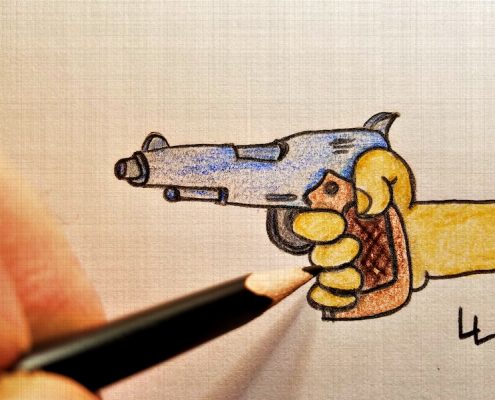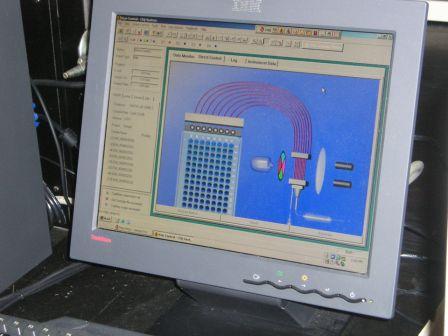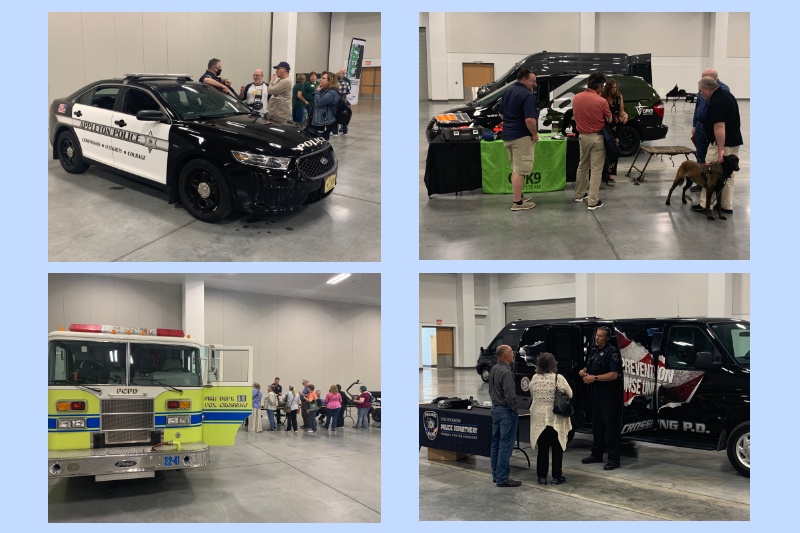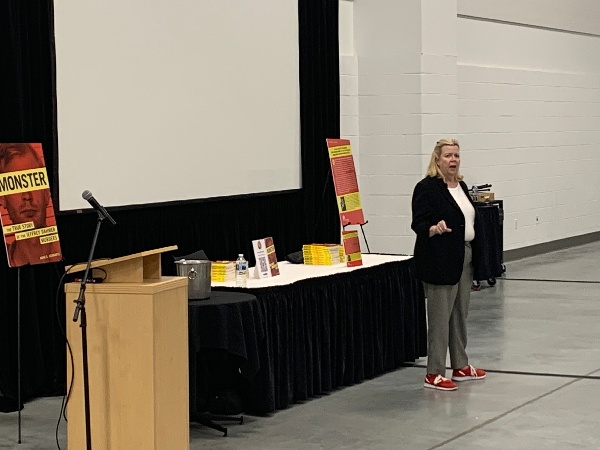The final two weeks of preparation for the annual Writers’ Police Academy passed by quickly, but eerily. I say it was eerie because there wasn’t a speck of trouble or problems. Well, other than presenters who backed out at the last minute. Fortunately, we filled those spots quickly, with fantastic speakers. In fact, we filled the spots almost as fast as the short time it takes to read this paragraph.
During that fortnight of preparation, Denene and I were busy designing and printing name tags and banquet meal tickets, creating spreadsheets for everything we could imagine, days of plotting and planning individual attendee schedules, devising backup plans in case the sunny weather forecast morphed into a rain-soaked weekend which would have grounded the helicopter, drenched the emergency vehicle driving track, and caused the K-9s to smell like, well, wet dogs.
But we were blessed with sunny skies and mild temperatures throughout the event.
Since we had a mountain of luggage, and boxes and bags full of WPA “stuff”, which was far too much to ship, Denene and I opted to drive to Wisconsin. A 16-hour trip, one way.
When it came time to load our vehicle, well, I felt like I was the tall green fellow in Whoville who was delivering a colossal bag filled to the brim with toys and floof to the Who girls and boys.
So many packages filled with snoof and tringlers and fuzzles; pantookas, dafflers and wuzzles. We had everything we could think of that we might need. Everything but the roast beast, which the event hotel assured me there’d be plenty of for everyone at the Saturday night banquet.

The day before we left home, we made a dry run to make certain the menagerie of cartons and cases fit into our vehicle and still leave room for two human passengers. And, after twisting, turning, shoving, and me grunting and groaning and spewing a long line of words that I didn’t know were in my vocabulary, I stood back to look at the result. What I’d created was a masterpiece. A work of art. Every bit and bob fit together into a giant, perfectly and tightly formed Jenga puzzle. Had one box slipped from its spot I believe the vehicle would have exploded.
The problem then was that I had to unload everything so we could fill the empty suitcases with enough clothing for ten days, stuff the empty boxes with registration goodies and other vital information, etc. Oh, I almost forgot the cooler. I couldn’t leave home without Coke Zero, bottled water, Cheerios, almond milk, gluten free bread and peanut butter, and jalapeno Cheetos (my crack)—the staples for a long road trip.
Denene knows me well; therefore, she knew it was likely I’d not remember how to accurately recreate the complex Jenga puzzle and, being a bulldozer in a china shop, end up destroying something when using my foot to stomp the &*$% out of the final box that refused to fit into its (im)proper place. Therefore, before unloading everything, Denene took photos to aid with re-packing. She’s a good wife who knows how to keep my blood pressure at a level that doesn’t send my brain jetting into orbit.
I drive a large pickup truck, a 2022 Chevrolet Silverado High Country. Hey, I’m a big guy who needs big space and comfort. Plus, we plan to do the obligatory retirement activity of using the truck to tow a travel trailer/5th wheel when heading south to visit family. Rick McMahan, one of WPA’s longtime core instructors and our good friend, said my truck was the size of a boat.
So, with our bags packed and truck loaded to the gills, we were ready to go. I filled up with gas ($4.49 per gallon) and off we went, with Steppenwolf’s “Born to be Wild” pumping from the speakers and the woman inside the dashboard telling me to drive X number of miles and to turn here and there, slow down, a speed trap is ahead, make a U-turn, do this, and don’t do that. My truck was also very talkative and pushy, ringing bells that warned me to slow down for school crossings, exceeding the speed limit (this one clanged more than once), alerting me to other cars that were too close to me on either side, and so on and on and on.
The next stop was for, well, you know, and to again fill up with gas—$4.69 per gallon. We consumed a peanut butter sandwich at this stop, and then we were off, in search of a hotel for the night.
We’d already traveled through four states, and it was quite late, past the hour of “nothing good happens at that time of night,” when we started our scan for roadside hotel signs. Finally, on that very dark desert highway, up ahead in the distance I saw a shimmering light. My eyelids had grown heavy, my sight dim. Yes, we’d found a hotel, and it was one in. chain that might rhyme with Killton. Relief at last.
However, we soon discovered we’d made an awful mistake in judgement when choosing this hotel. I promise, our experience there is not indicative of this chain’s properties, but I must share with you the tale of this overnight hell.
After exiting the main road I pulled beneath the covered drive at the front door of the sleeping establishment. This being the only hotel we’d seen for miles and miles it, I hoped it was an oasis where we’d get some much-needed rest.
When the automatic front doors parted I was greeted by an odor like I’d not experienced before. Not quite terrible, but slightly offensive. My senses told me to turn around, but the need for sleep pushed me inside. Still, there was a nagging feeling that we’d stepped inside “Motel Hell,” the fictional hotel from the 1980 comedy horror film of the same name. In the movie, the hotel is run by Vincent Smith, a farmer, butcher, and motel manager who traps travelers and harvests them for his popular smoked sausages made of human flesh. I wondered about the off-putting scent pouring into my nostrils and immediately scanned the area for homemade sausages.
The desk clerk at our hotel (not Motel Hell, but close) was a man who looked young enough to be fresh out of high school. When I approached the counter, I saw him seated at a desk in a backroom, in full view of the front counter, intently watching a video. He didn’t hear me come in. I called out to him a few times before I got his attention. He finally walked to the counter at the pace of a snail who’d overdosed on tranquilizers.
When this slender, frail person finally made it to the front desk he simply stood there. His thick round glasses made his eyes appear to be the size of marbles. When it became clear that he had no intention of speaking I asked if he had a room available for the night. He nodded once but still did not say a word.
The odd guy, still without speaking, handed me a paper with spaces highlighted in purple. Being the detective that I am I figured out that two spaces required my initials and the third a signature. Then he spoke. “I need your ID and credit card,” he said. His voice was quiet and tranquil, like the voice a parent uses when trying to convince a baby to sleep.
Well, the computer system wasn’t working so he completed the transaction by hand, old school style. As he handed me the card key he said in his unique snoozy tone, “There’s a problem with the hot water.”
Me – “We WILL have hot for showers, RIGHT?”
The pasty man with fingers barely larger than spaghetti noodles (the tiniest fingers I’ve ever seen other than those of a infant) didn’t reply. Instead, he very slowly shrugged his shoulders, and by slow, I mean it took him 7 full seconds to raise and lower his shoulders.
So, I asked again. Another slow shrug of his shoulders.
Ordinarily this would have been my final clue to head out the door and move on to another hotel. But we were in the middle of Stretch of Nowhere, Ohio. Population … one guy who works at the only hotel for miles and miles. And we were exhausted.
So, I grabbed a luggage cart and began the laborious process of unloading the Jenga puzzle in reverse order for transfer to the hotel wagon. Once it was loaded to above my eye level with cartons and cases bulging from all sides, I then leaned into the task of pushing the grossly overloaded trolley toward our room, straining my legs and back along the way. The cart, by the way, was so heavily laden the excessive weight caused its well-worn wheels to moan like a wounded animal while digging deeply into the cheap, stained carpeting in the hallway.
I opened the door to the room and the yucky odor inside was even more pronounced than the funk permeating the air in the lobby and corridor. The source of the stink, we believed, was a large sofa cushion sized area of black mold on the bathroom ceiling. The drapes were badly torn and couldn’t be closed on their own. Denene creatively pinned them shut using the metal clips on the in-room clothes hangers. Then she, being an astute microbiologist and immunologist, broke out a package of alcohol wipes and proceeded to disinfect every reachable surface in the room. The only thing in the room that was clean and fresh smelling was the bedding (we tossed the comforter and used only the sheets).
The a/c barely worked, and when it did it rattled like someone emptying metal garbage cans into a refuse truck.
The hotel was like one you’d see in a low budget film featuring crack dealers and prostitutes.
Somehow, we made it through the rest of night without being attacked by bedbugs, roaches, rats, or drug dealers and prostitutes. But the next morning, as I feared … NO HOT WATER. Not a drop. It was like showering in ice water. What I didn’t foresee was the power outage that occurred when I stepped from the shower. It was 80 degrees outside, and it didn’t take long for the heat to rush into the room once the ailing a/c unit wheezed its last breath.
I repacked the Jenga game into the truck, using the photo as a guide, and then filled up with gas—$4.89 per gallon.
The rest of Ohio was uneventful, but the further we traveled the higher the price of gas. The next stop it was $5.59 per gallon.
We spent the night in Wisconsin, in town that’s been in the news quite a bit during the past couple of years. That’s not why we stayed there, though. We picked it because there was a variety of hotels and restaurants. We struck gold this time because the hotel was quite pleasant as was the food. And gas prices were heading down—$4.59.
The next day was a shorter drive and in just under three hours we pulled into the rear private parking lot of the impressive Fox Cities Exhibition Center in Appleton, WI, the location of the nighttime activities of the 2022 Writers’ Police Academy.
The Fox Cities Exhibition Center is attached to the Hilton Paper Valley Hotel, our official event hotel).
The 2022 WPA was a fantastic event, one of the best we’ve produced to date.
Of course, there was the one night during our stay when the local police were called by hotel security to assist with booting the gaggle of loud and rowdy underage alcohol-consuming partiers from the room next to ours. I learned the next day that the mother of one of the teens rented the room as a graduation present. And, as teens do, they invited all their friends over, also under legal drinking age, to yell, scream, squeal, shriek, giggle, bang on walls, stomp on floors, and play music at ZZ Top concert levels.
Security visited the room twice to ask the group to hold down the noise. I heard the security officer say, “This is your final warning.” He was soft-spoken, yet firm, and he was built like a small tank. He had the widest shoulders I’ve ever seen on a real person. It looked like he’d inserted a six-foot 2×4 inside his suit jacket, lengthwise across the tops of his shoulders.
Think of a torso shaped like Spongebob, with a human head on top and arms and legs protruding from their appropriate locations. A waist length braided ponytail, and a small black hoop ring inserted through one eyebrow. This guy is tailor made to be a character in a novel.
After the final warning and with the party still in full swing, SpongeBob’s patience was a thing of the past, as was mine (we had to get up a 5 a.m. and by this time it was after two. He called the police to assist with the eviction.
Yes, there’s nothing like a booming “cop knock” on a metal door in the wee hours of the night/morning, followed by the gentle sound of a police officer’s timid voice when he shouted, “POLICE! OPEN. THE. DOOR. NOW!” Then, “PACK. YOUR. STUFF. AND. GET. OUT!”
Mom was not happy when she was roused from her sleep with a call to come pick up her daughter who’d been evicted from the hotel and was currently standing on the sidewalk outside the hotel.






























 crime documentaries and magazine shows, is an executive producer of Murder House Flip, and has consulted for CSI, Bones, and The Alienist. The author of more than 1,500 articles and 69 books, including The Forensic Science of CSI, The Forensic Psychology of Criminal Minds, How to Catch a Killer, The Psychology of Death Investigations, and Confession of a Serial Killer: The Untold Story of Dennis Rader, The BTK Killer, she was co-executive producer for the Wolf Entertainment/A&E documentary based on the years she spent talking with Rader. Dr. Ramsland consults on death investigations, pens a blog for Psychology Today, and is writing a fiction series based on a female forensic psychologist.
crime documentaries and magazine shows, is an executive producer of Murder House Flip, and has consulted for CSI, Bones, and The Alienist. The author of more than 1,500 articles and 69 books, including The Forensic Science of CSI, The Forensic Psychology of Criminal Minds, How to Catch a Killer, The Psychology of Death Investigations, and Confession of a Serial Killer: The Untold Story of Dennis Rader, The BTK Killer, she was co-executive producer for the Wolf Entertainment/A&E documentary based on the years she spent talking with Rader. Dr. Ramsland consults on death investigations, pens a blog for Psychology Today, and is writing a fiction series based on a female forensic psychologist.


